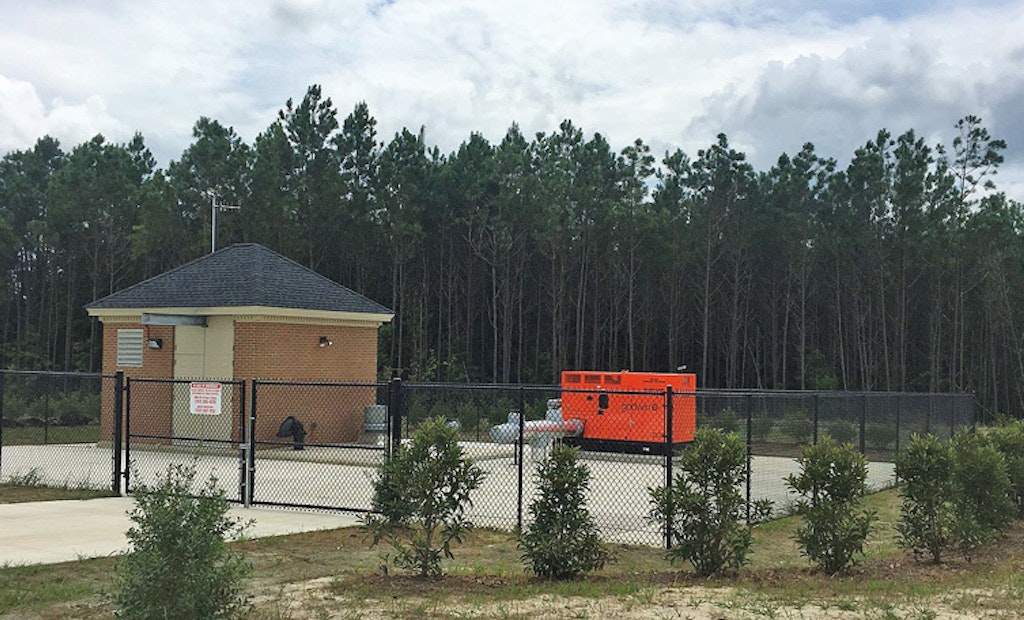
Interested in Infrastructure?
Get Infrastructure articles, news and videos right in your inbox! Sign up now.
Infrastructure + Get AlertsA big storm sweeps through town and knocks out power to your most critical lift station. Luckily, it’s equipped with a backup generator. But then debris chokes the pump.
Lift station redundancy is invaluable. In Isle of Wight County, located 20 miles west of Norfolk in eastern Virginia, the Department of Public Utilities has taken a novel approach to ensuring their stations never stop pumping.
The Department of Public Utilities maintains the county’s sewage collections system, which serves a population of about 35,000 people. Gravity lines and force mains, supported by 32 lift stations that address the Isle of Wight’s generally level topography, feed into a regional wastewater treatment plant. Minimizing sanitary sewer overflows due to lift station failures is particularly important.
“We’ve got a clean track record of preventing sanitary sewer overflows from our stations,” says Steve Hatcher, public utilities operations manager for Isle of Wight.
“One of our key techniques is implementing redundancies whenever possible, whether it’s upgrading an existing station or putting in a new one.”
At the newest of Isle of Wight’s 32 lift stations — supporting the new Benn’s Grant residential development — the Public Utilities Division needed to accommodate new sewer lines and equip a new lift station to support the flow. The department wanted the station outfitted with a fail-safe backup system.
The industry standard for lift station redundancies is to install a diesel-driven generator that fires up when the power goes out. This solution has been a perfectly reliable backup in case of power failure, but a generator is of little use if the station’s switchgear or primary pump fails.
New twist
The utility turned to the local Xylem branch for an option that would build in system redundancies. The recommended solution added a new twist on existing technology — redundant and independently powered backup pumping in one package for a variety of emergency situations. It made perfect sense to Hatcher and his team.
The Xylem team engineered a more complete solution featuring a Godwin Dri-Prime Backup System (DBS) capable of handling the estimated 1,420 gpm flow rate expected at the new lift station. The Godwin DBS is an independently powered backup pump that runs on diesel, and is permanently installed in a lift station.
Plumbing directly into the wet well with independent sets of floats, the system automatically protects against loss of power, in the event of transfer switch malfunction, as well as control panel, transducer and permanent pump failures.
To handle the flow rates at the Benn’s Grant lift station, the utility went with a diesel-driven Godwin CD225M critically silenced pump. The new backup pump triggers on and off via level floats in the wet well that are set at predetermined levels. If the water rises due to a failure of any kind, the backup diesel pump kicks on and the lift station continues to move water. Additionally, the backup pump will turn on and support the primary pump if a 100-year storm event inundates the lift station with an overwhelming amount of flow. This extra capacity further reduces the possibility of an overflow.
The backup pump is also equipped with a Godwin PrimeGuard controller to provide greater visibility and peace of mind. The controller sends signals to the county’s SCADA system, notifying department personnel that the backup pump is running, so they can initiate a visit to the lift station if needed. Another great benefit to the county is the system’s ability to only activate the backup pump when needed, therefore saving fuel and limiting operating hours. When a lift station is equipped with a generator, it runs constantly the whole time the power is out, whether the pump station is requiring standby power or not. As a result of the increased efficiencies and critical service reliability required by Isle of Wight, they have incorporated backup pumps into their standards and specs for all new lift stations and rehabilitation projects.
Besides providing 100 percent redundancy, the Godwin DBS provides convenience to Hatcher and his team. Whenever the primary pump in the lift station requires repair or maintenance, crews can manually start the permanent backup pump, which is much easier than bringing in one of the department’s 11 portable pumps for a temporary hookup.
Additional features
Beyond the technical performance specifications, the department requested work lights and a battery charger in case of nighttime work and to ensure remote access to the pump controls during a long-term power outage event. In addition, to manage the chilly Virginia winters and prevent freezing during low-flow activity, the backup pump was outfitted with a block heater and exposed piping was insulated.
Isle of Wight has now equipped six of their 32 lift stations with Xylem’s independent backup pumping solution. As they map out their maintenance and upgrade activity, the county plans to upgrade their other lift stations with the same system.
“The Godwin DBS that Xylem offers makes so much sense for our network,” Hatcher says. “It gives us the dependability of a tried-and-true product and delivers real peace of mind. No matter what happens, our lift stations will have the capability to move water — and knowing that is very reassuring.”






